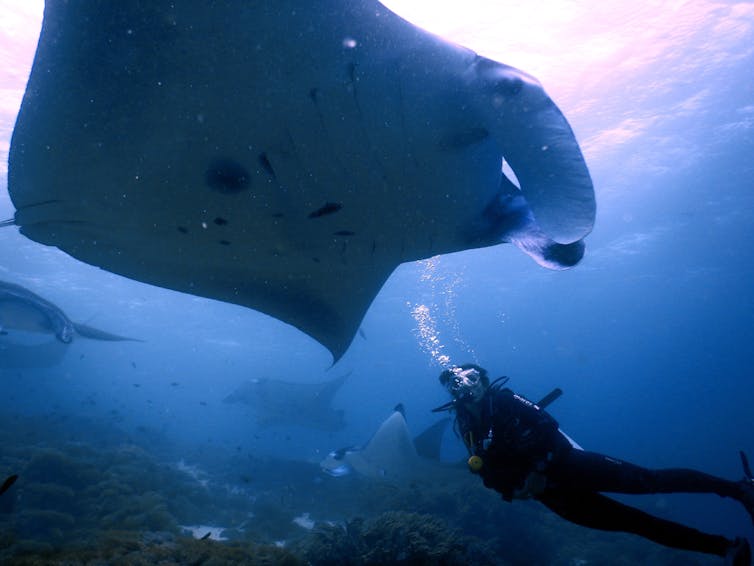
[ad_1]
Topic to overfishing, marine megafauna – similar to sharks, rays, and turtles – are among the many world’s most threatened species teams. Considerably paradoxically, these species even have widespread enchantment.
Vacationer actions, similar to scuba diving place appreciable financial worth on these species. One examine values international manta ray tourism at US$140 million (£116 million) every year.
Marine tourism is commonly promoted as a extra conservation-compatible substitute to unsustainable fishing. Nevertheless, regardless of its worth, marine tourism not often contributes immediately in direction of conservation. The financial worth of those species is usually extracted by the tourism trade and barely filters immediately into conservation actions.

Hollie Sales space, Creator offered (no reuse)
Coastal communities that rely on marine megafauna for meals and earnings are, in distinction, not often nicely positioned to learn from marine tourism.
And topic to restrictive rules, the prices of marine conservation additionally typically fall on these communities. One examine estimated, for instance, that catch limits on endangered shark species may price low-income Indonesian fishers as much as 17.6% of their annual income.
A ‘beneficiary pays’ method
A possible answer to this inequity is a “beneficiary pays” conservation method.
Right here, a price is levied on vacationers or tourist-focused companies. The proceeds are then invested into community-based conservation initiatives, which offer coastal communities with the assets to facilitate conservation, whereas supporting their livelihoods.
In a current examine, my colleagues and I investigated the feasibility of this method.
Utilizing a web based survey of individuals with a basic curiosity in journey, we established the willingness of worldwide marine vacationers to pay in direction of community-based shark conservation. Contributors have been offered with a state of affairs during which they have been at a tropical seaside vacation spot. They have been additionally knowledgeable of a close-by neighborhood extremely depending on catching endangered sharks.
Given this state of affairs, individuals have been requested the utmost quantity they might pay for a marine conservation price. The price, added to the worth of marine actions, would immediately compensate native fishers for decreasing their catch of endangered shark species.
By combining the typical willingness-to-pay per individual with market information from two in style Indonesian vacation locations – Lombok and Pulau Weh, each dwelling to a number of endangered shark species – we estimated how a lot conservation income might be raised yearly.
Extensive help for tourism levies
Our outcomes present large help for tourism levies.
Survey respondents have been keen to pay a every day common of US$10–15 (£8.25–12.37) per individual in direction of community-based marine conservation initiatives.
This corresponds to US$2.3–6.Eight million (£1.9–5.6 million) per yr in Lombok and US$300,000–900,000 (£247,000–742,000) per yr in Pulau Weh in potential income for coastal communities. The decrease estimate is predicated on a levy of US$10 per day and in the future of marine actions per vacationer, and the higher primarily based on US$15 per day and two days of marine actions per vacationer.
These revenues exceed the estimated prices of community-based shark conservation in close by fisheries. Pilot initiatives are already ongoing in these communities, whereby fishers are compensated for releasing critically endangered species, with some early success.
Direct funding
Marine tourism is an underutilised income for marine conservation. Nevertheless, financing mechanisms have to be appropriately designed.
Respondents in our examine expressed robust preferences for funding environmental NGOs or direct funds to native communities. There was much less help for paying a levy to nationwide or native governments. This suggests that for marine tourism levies to achieve success, the revenues have to be brazenly distributed to locally-run initiatives.
Our analysis additionally discovered that travellers’ willingness to pay trusted their vacation funds. Due to this fact, conservation income could also be increased in luxurious locations and much decrease for funds locations. This highlights the necessity for mechanisms to be tailored to native contexts and markets.
We’d additionally counsel, primarily based on our findings, that providing details about marine conservation on the “level of sale” might not be wanted. We discovered that present pro-environmental behaviours led to a better willingness to pay. Offering data on shark conservation points immediately previous to the survey had little impact on the willingness of individuals to pay.
Over 80% of respondents additionally agreed that they might be extra more likely to buy items and companies from environmentally acutely aware tourism firms. This additional raises the likelihood that firms who incorporate conservation levies into their costs could even be deemed extra engaging by prospects.
Reef areas entice about 70 million vacationers yearly. If every vacationer is keen to pay simply US$10 (£8.25) per journey, marine tourism levies may generate no less than US$700 million (£580 million) for marine conservation yearly, and in doing so make sure that weak coastal communities don’t bear the total prices.
Marine tourism levies can turn out to be a key financing mechanism for delivering international biodiversity objectives and addressing mismatches between the prices and advantages of marine conservation. However provided that they’re appropriately designed. There’s a clear alternative for tourism operators, governments, NGOs, and coastal communities to develop partnerships to make sure the potential of marine tourism levies could be realised.
[ad_2]
Supply hyperlink